Grape Day shows San Joaquin Valley growers ‘what works in our area, for our crops’
UC scientists provide updates on innovations in managing water, nutrients, pests, disease in vineyards
Grape Day at the Kearney Agricultural Research and Extension Center – a time-honored learning event dating to the late 1960s – was convened again on Aug. 12 for wine, table and raisin grape growers to hear about the latest field trials and innovations.
“The primary purpose of Grape Day is to showcase research that University of California faculty, specialists and advisors are doing to benefit the California grape industry, and particularly for growers in the San Joaquin Valley,” said Matthew Fidelibus, UC Cooperative Extension specialist in the UC Davis Department of Viticulture and Enology.
Fidelibus has been organizing the biennial Grape Day at Kearney REC – operated by UC Agriculture and Natural Resources and located in Parlier, Fresno County – since 2005. The first Grape Day was held in Davis in 1951, and the first at Kearney REC took place in 1967.

Bill Chandler, whose family farm has been growing a variety of crops in the area since the 1880s, has attended many Grape Days. He said the research projects, which reflect local growing conditions, provide invaluable insights.
“All the growers here are appreciative of the Kearney field station; there’s good people here and we want to support them,” said Chandler, whose wife Carol serves on the UC President’s Advisory Commission on Agriculture and Natural Resources. “They’ve really helped us out with knowing what works in our area, for our crops.”
The Kearney Grape Day in the summer and the San Joaquin Valley Grape Symposium in the winter are the longest-running grape meetings in the valley, according to George Zhuang, UCCE viticulture farm advisor for Fresno County.
“These events provide all the cutting-edge viticultural information, ranging from water and nutrient management to cultural practices and vineyard mechanization,” Zhuang said. “Those two meetings are well-attended and their impact has been revolutionary.”
Growers learn more about old nemesis, new variety
After a burrito breakfast courtesy of American Vineyard magazine, the 50 attendees –growers, industry professionals, researchers and collaborators – boarded a tram. During the first part of the day, they visited experimental vineyard blocks at Kearney REC.
At the first stop, Andreas Westphal, professor of Cooperative Extension in the Department of Nematology at UC Riverside, provided an overview on the biology of nematodes – microscopic roundworms that can rob grapevines of vigor and yield.
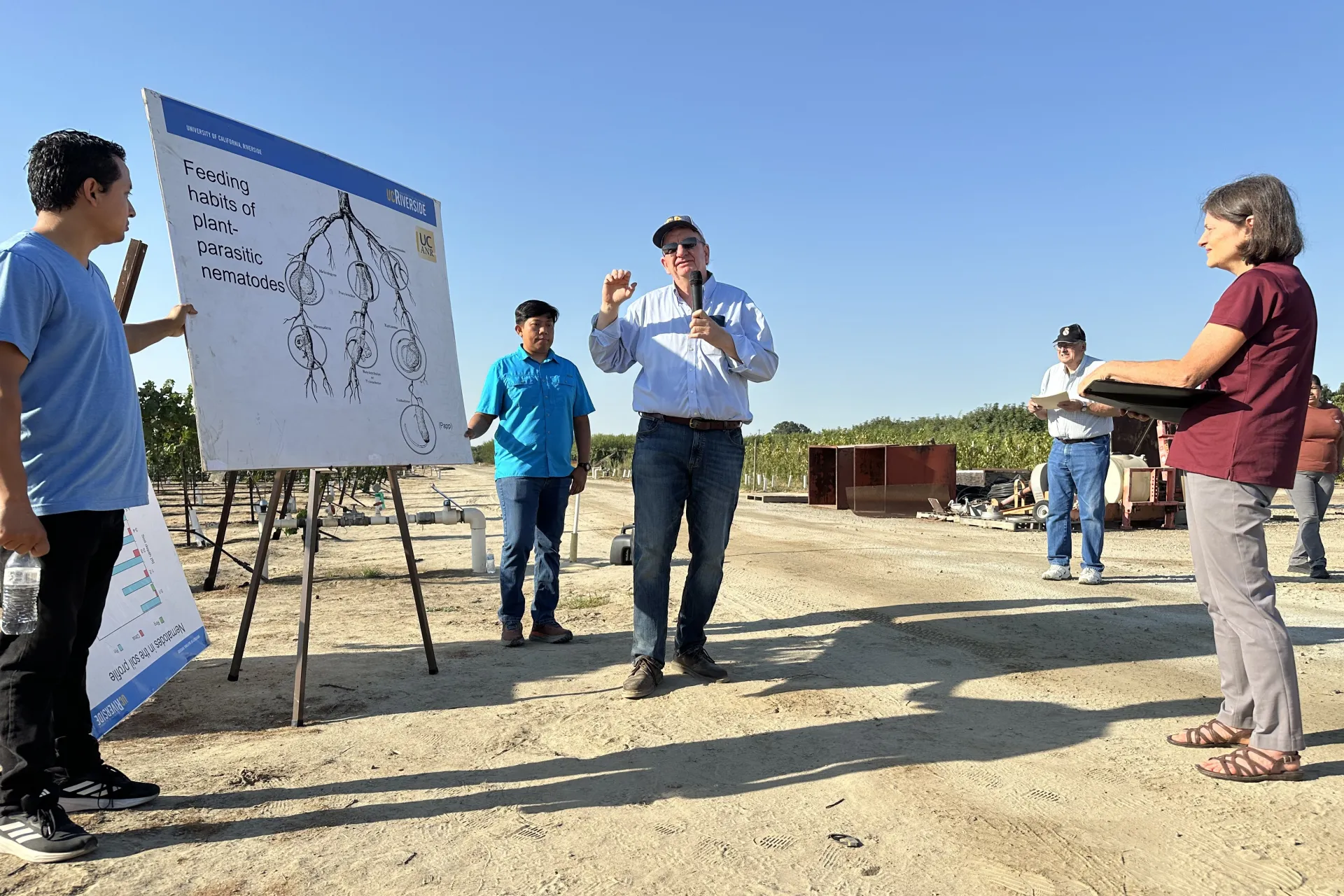
Westphal summarized the feeding habits and life cycle of this notorious pest. “Vineyards can concurrently host multiple nematode species,” he said.
An efficient way of managing these populations is through resistant and tolerant rootstocks. In Westphal’s work on rootstock development in collaboration with various breeders, some elite rootstocks look promising.
Because it is challenging to identify rootstocks that concurrently cope with several nematode species, Westphal also investigates pre- and post-plant treatments for nematode management. He emphasized the importance of monitoring for these soil-dwelling pests to guide management decisions as post-plant tools become available.
“If you can commit to annual sampling, that will do you a world of good,” he said.
Next, Fidelibus took attendees to see several rows of Sunpreme dry-on-vine (DOV) raisin grapes. He explained his plans to study, at a physiological level, one of the primary problems with the Sunpreme variety that was released in 2017 – preharvest fruit drop, or “shattering.” With a better understanding of that process, he hopes to develop more useful management strategies.
Sunpreme research is especially important, given the relatively small number of grape varieties that can produce acceptable raisins, said Luke DeBenedetto, a grower support and research coordinator for Sun-Maid Growers of California.
“As of right now, Sunpreme is the only tried-and-true self-drying variety out there – where we can potentially do the mechanical harvest and pruning practices – that will hopefully keep the raisin industry alive for the foreseeable future, with older varieties being pulled out left and right,” DeBenedetto explained.
He added that he continues to work with the UC Cooperative Extension scientists to refine cultural practices and farm management techniques.
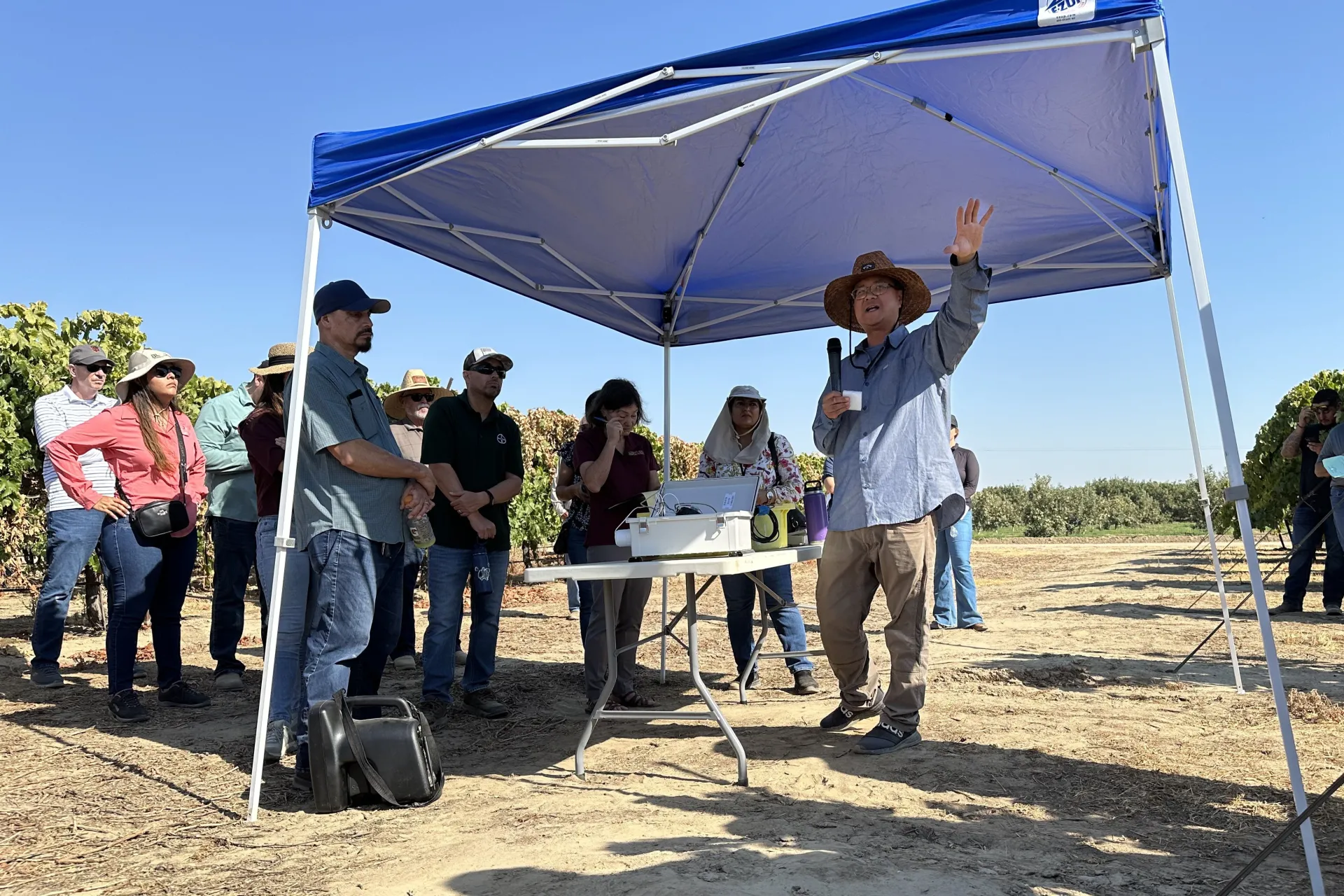
“Matt [Fidelibus] and George [Zhuang] have been very influential in some of the decisions I’m making at our own research facility,” DeBenedetto said. “We’re actually planting Sunpreme out there this fall, and we’re trying to build off their existing research.”
UCCE advisors share tools and tips, test innovations for grapes
At the next stop, Zhuang displayed several instruments on a table, including a flowmeter, tensiometer and data logger. Pointing to a 4G LTE antenna, Zhuang explained it can provide real-time data to power the CropManage decision-support tool.
He encouraged growers to explore the online tool and apply for grants (such as through the State Water Efficiency & Enhancement Program, or SWEEP, from the California Department of Food and Agriculture) so they can install additional equipment to existing weather stations.
That way, Zhuang said, growers not only have access to the powdery mildew index that can help determine the appropriate response to disease pressure – but also key data on soil moisture and climactic conditions that inform more effective irrigation management.
“To quote UC Davis Professor Emeritus Larry Williams: ‘If you can’t measure, you can’t manage,’” said Zhuang, who added he is planning a hands-on CropManage workshop at Kearney REC for the fall.
Joy Hollingsworth, UCCE table grape advisor for Tulare and Kings counties, showed the attendees her experiments with red-colored panels from Opti-Harvest, a company that says their Opti-Panels can reduce labor costs associated with training, pruning and leaf removal.
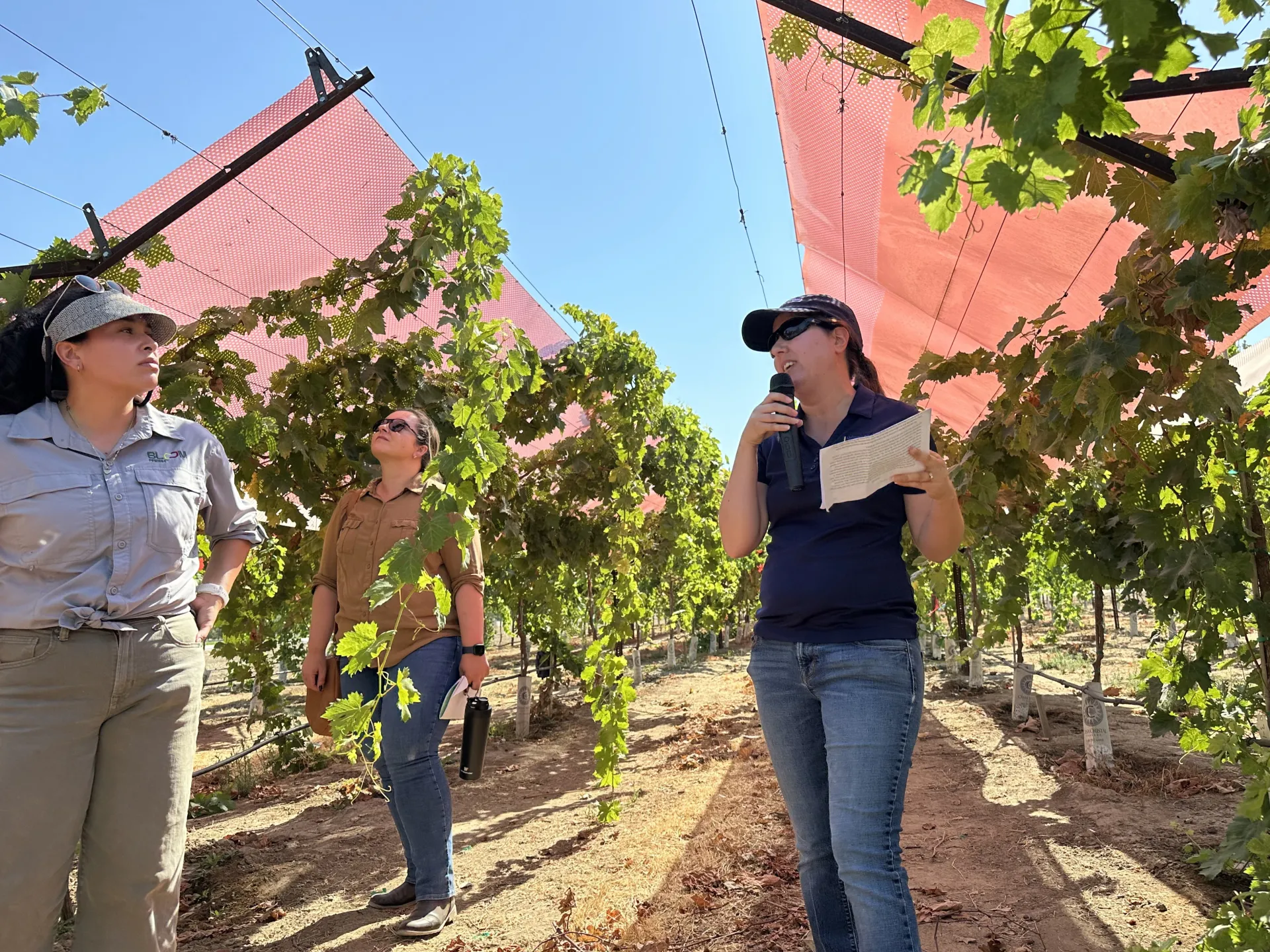
“We wanted to see exactly what effect these panels have on the vines,” said Hollingsworth, who affixed the shade-like panels to trellises of Valley Pearl green table grapes in March.
She has been looking at the temperature, humidity and light levels for exposed vines and the vines under single panels and double-thick panels – as well as the physical characteristics of the grapes and vines under the different conditions.
Although Hollingsworth noted that she only has preliminary observational findings, she said there was a small but discernable difference in berry color, with the grapes under the panels appearing to be more green than the exposed ones.
Wrapping up the field tour portion of the day, Jorge Angeles – UCCE weed management and ecology advisor for Tulare, Kings and Fresno counties – lined up a row of grapevines in containers, each treated with low amounts of various herbicides to mimic the level of exposure from herbicide drift.
Angeles pointed out the different modes of action for each product, as well as typical symptoms, such as cupping of leaves and necrotic tips on the vines. He also emphasized that growers should note when symptoms first start appearing and how they progress.
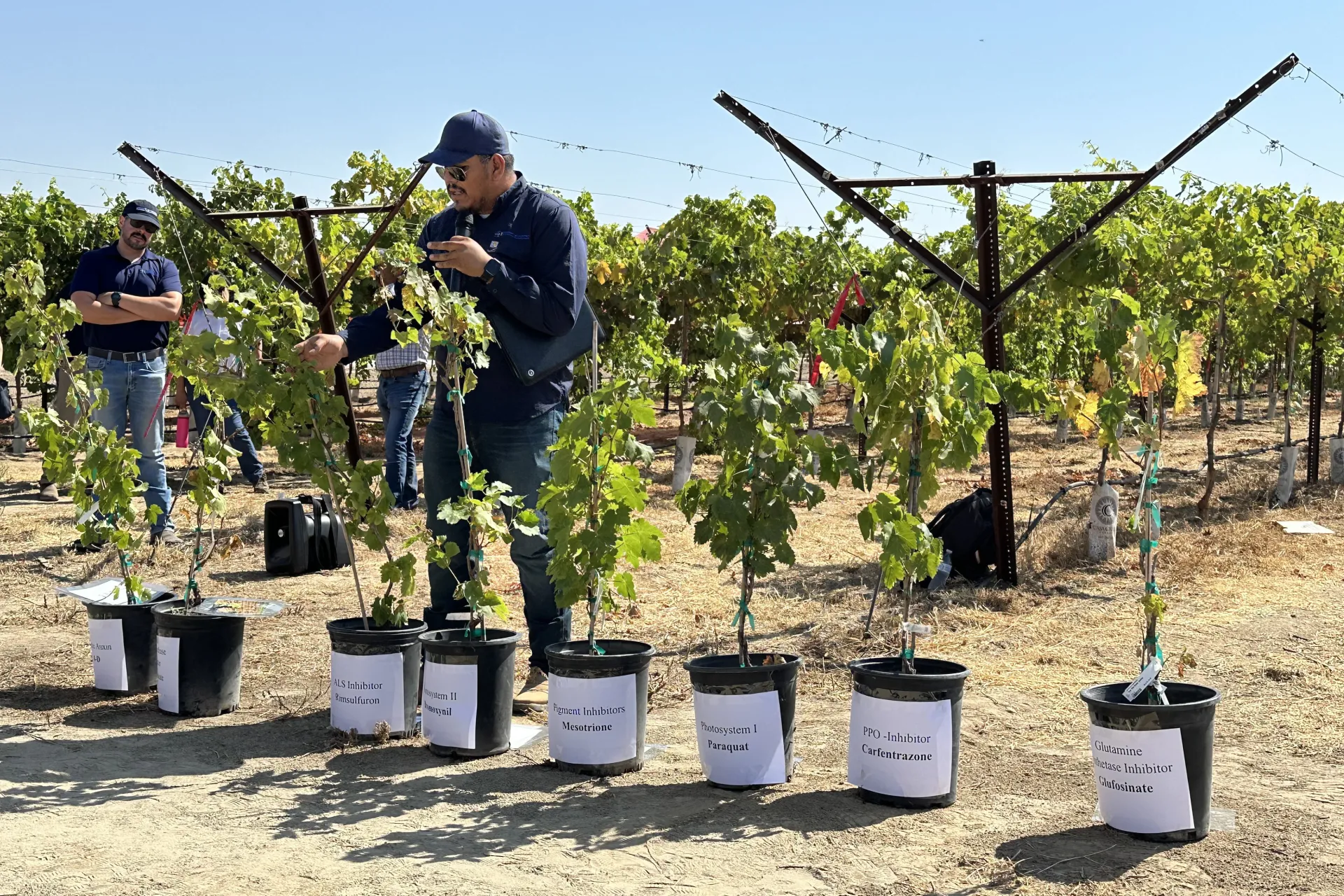
“Accurately diagnosing possible herbicide injury in vineyards is difficult since many biotic and abiotic factors can cause similar symptoms,” Angeles said. “But knowing the herbicides used, evaluating symptom progression, injury patterns in the field, environmental conditions and soil characteristics can help confirm or rule out herbicide involvement.”
Researchers discuss AI modeling, study of products to mitigate heat stress
Attendees then moved to a Kearney REC classroom, where they heard from Alireza Pourreza, UC Davis associate professor of Cooperative Extension in the Department of Biological and Agricultural Engineering.
Pourreza challenged everyone to guess – by sight and intuition alone – which of three grape leaves had the highest nitrogen content. Then he used a handheld spectral scanner on the leaves to obtain measurements within seconds (most attendees picked the correct leaf).
That sensor data can now be used, Pourreza said, to predict a broad range of plant characteristics, including crucial mineral nutrient levels. He and his team at the UC Davis Digital Agriculture Laboratory had obtained 1,000 leaf samples, measured their “spectral reflectance” with the sensor, and determined how various traits are correlated with each other. They developed an AI model, hosted in the cloud, to crunch the numbers from a sensor reading and then display a full profile of estimated leaf traits on a mobile app.

Pourreza also discussed how that reflectance data can be obtained by drones equipped with multi-spectral cameras, and how the use of virtual or “synthetic” imagery can help further train and enhance the AI model.
Then Ashraf El-kereamy, UCCE specialist in the Department of Botany and Plant Sciences at UC Riverside, shared the results of testing two products aimed at mitigating heat stress on table grapes.
“Vines are like us – they have feelings; they have a nervous system, it is called the signal transduction pathway,” said El-kereamy, who is also director of UC ANR’s Lindcove REC.
He found that the two treatments – when applied at the manufacturer’s recommended full rate – were effective in bolstering the vines’ protective cuticle layer and boosting heat tolerance.
El-kereamy also emphasized the importance of other practices in mitigating the effects of heat (such as shade management) – and prioritizing overall plant health. “Try to avoid any other kind of stress on the grapes, so when the heat wave does come, it doesn’t affect the vine,” he said.
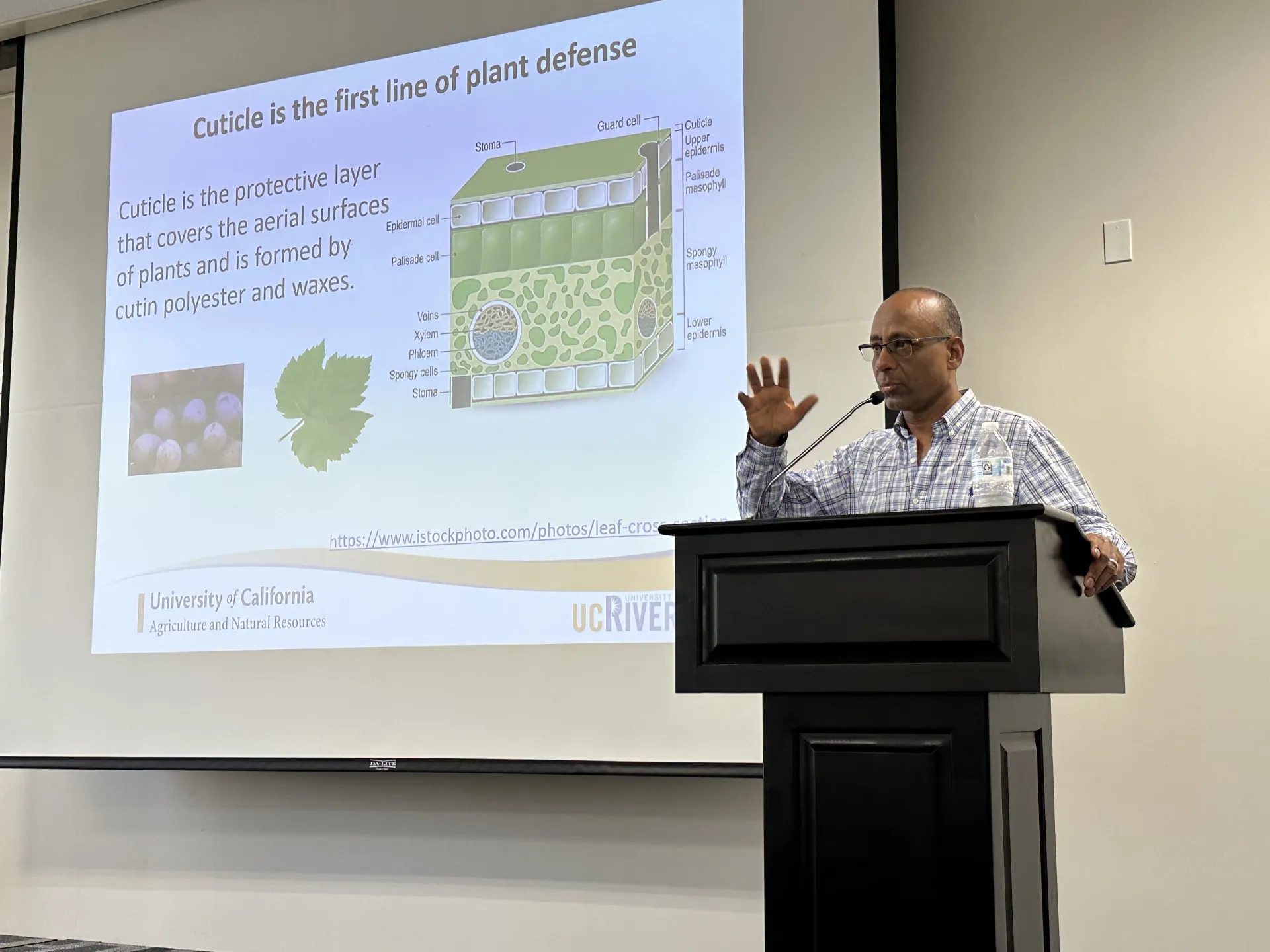
The research projects led by El-kereamy and Pourreza received support from the California Table Grape Commission. Maha Afifi, director of the viticulture research program at the commission, attended Grape Day to hear updates on the work.
“Both projects have provided useful findings that could enhance cultural practices for California table grape growers, to improve grape quality and productivity,” said Afifi, who noted that the commission is collaborating with UC scientists on multiple research priorities.
To close out the day, Karl Lund, UCCE viticulture advisor for Madera, Merced and Mariposa counties, gave a presentation he titled “Canopy Management: What Could Go Wrong.” He had conducted two trials investigating the impact of shoot thinning and “skirting” the canopy at a vineyard north of Madera.
Lund found that shoot thinning had very few or inconsistent effects on fruit size, yield and quality for the limited number of varieties he studied in the first season. In the second season, he observed a more consistent tradeoff of slightly higher Brix (sugar) levels for major loss of yield.
“After seeing the second year of data the grower and I quickly concluded that this was not a good tradeoff, and we moved to the next trial,” Lund concluded.
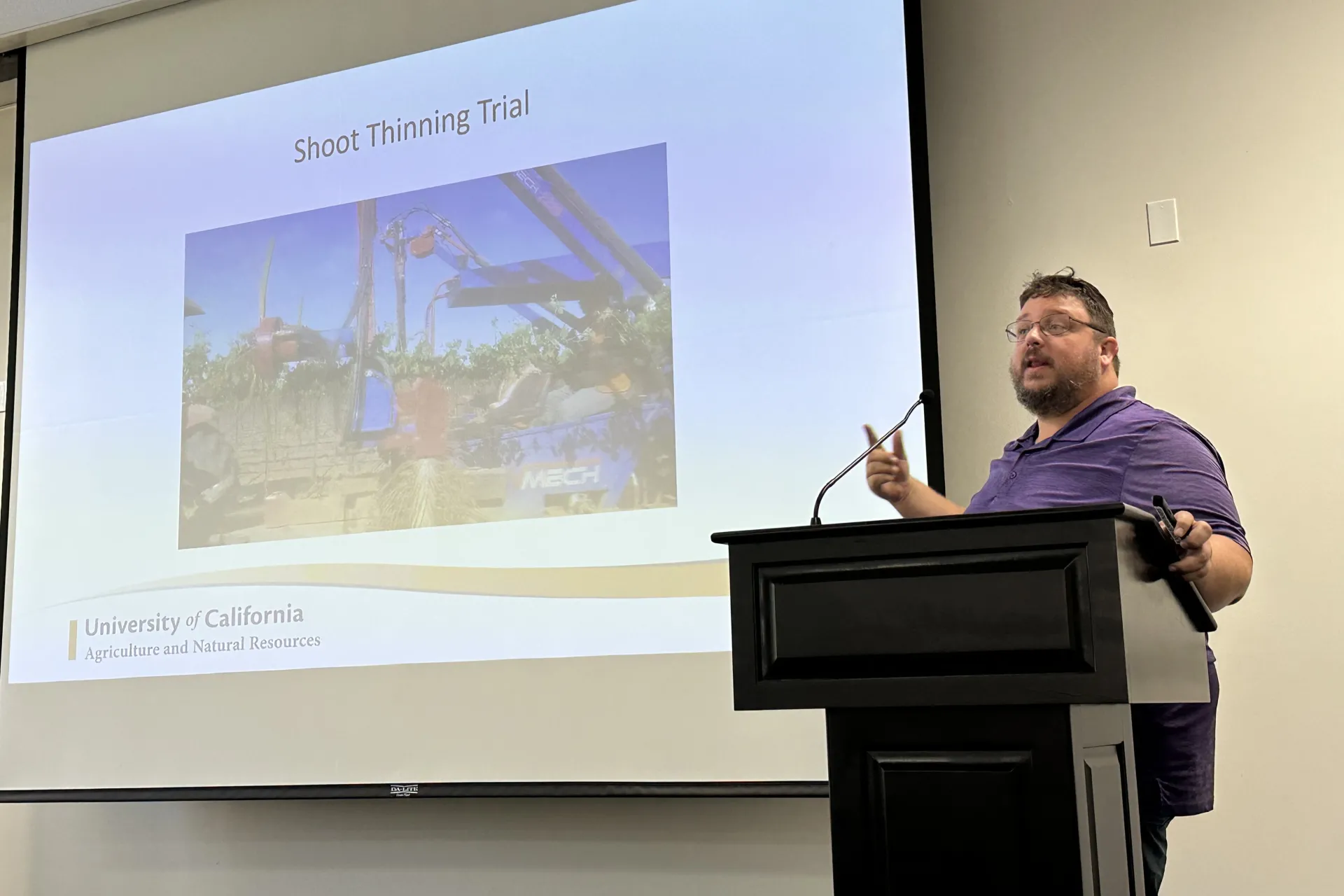
The “skirting” trials looked at removing the lower portion of a sprawling canopy. Lund found that removing all of the canopy between the ground and a line two feet below the cordon wire did not affect fruit chemistry. However, he also found that these treatments didn’t improve berry health by preventing issues such as bunch rot.
“The treatment didn’t seem to be a bad thing, but it also isn’t something you should be paying extra to do,” said Lund, who self-deprecatingly lamented that his hard work over three years did not appear to result in concrete “how-to” recommendations.
A grower in the audience assured Lund that learning what not to do was just as helpful.
